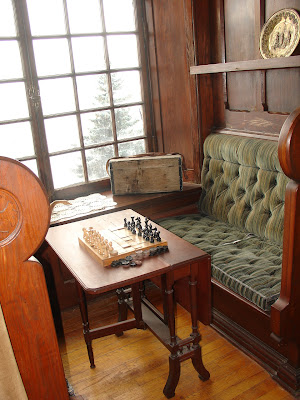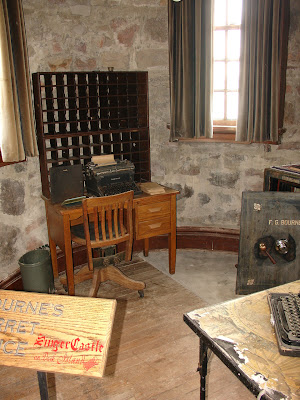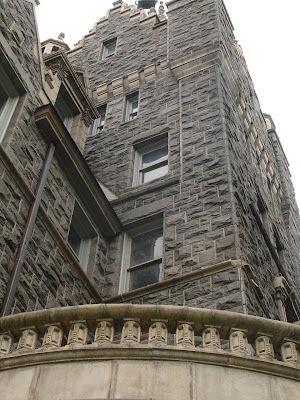During our trip to the Thousand Islands, G and I took a river boat tour to Dark Island to visit the castle.
I was told that this castle was more medieval than Boldt Castle and that it had many secret passageways.
The river boat traveled at 6 knots, and it took an hour to go nine miles from Alexandria Bay to Dark Island.
History
In 1902 Frederick Bourne, president of the Singer Manufacturing Company decided to purchase this 7-acre island in the Thousand Island region where he built what he fondly referred to as a hunting lodge. There years later, his "hunting lodge" modeled after the castle in Sir Walter Scott's historical novel Woodstock was complete. He named the castle The Towers after the castle in the story.
The Bournes enjoyed the castle for 14 years until Bourne's death in 1919. Two of his daughters May Strassburger and Marjorie Bourne purchased the castle. May gave lifetime use of the castle to Marjorie. Marjorie married Alexander Thayer in 1926, and the couple spent the next 35 summers there.
Marjorie passed away in 1962 and deeded the castle to LaSalle Christian brothers who apparently had no use for it and sold it to the Harold Martin Evangelistic Association in 1965. Dr. Martin renamed the castle "Jorstadt Castle" after his grandfather, a Norwegian sea captian.
Opening the castle doors to the public for the first time, the castle was used for spiritual retreats and Sunday chapel services even after Dr. Martin's death in 1999.
In 2002 the castle was purchased by an investment group named Dark Island Tours, Inc. and its name was changed to Singer Castle.
The Garden
View of the Saint Lawrence River from the castle bridle path.
Dark Island is a favorite tourist attraction with many visitors during the open season. Visitors are divided into small groups and taken on a fast-paced guided tour.
The massive, wooden front doors open into the great hall.
Massive stone arches, infinity mirrors, medieval weaponry, and three medieval suits of armor purchased by Bourne create an atmosphere of stepping back in time.
Off the great hall is Bourne's library. Note the panel to the left of the fireplace.
The panel opens to reveal a hidden passageway!
The original dining room has a table fitted with hidden buttons that call the servants. A large mirror on one wall and a grate on the opposite wall are positioned for a strategic purpose.
A servant could peer through the grate to see the mirror at the other end of the room. The mirror reflected the dining table and diners back to the servant, and the servant could make sure that diners had all that they required.
The mirror.
The peep grate. I wonder if guests realized they were being spied upon.
A hidden passageway in dining room for servants to move about the house unseen. They could just appear and disappear causing little disturbance.
This room was originally furnished as Bourne's living room.
The Pullman seating provided a cozy place for the gentlemen to retreat for brandy and cigars after supper.
Hopefully, the gentlemen didn't indiscretely speak of anything that should not be repeated since the room had another spy hole; a tilting portrait.
Bourne's turret office.
Loggia
The Bourne's Master Suite
Master bath
Female servant's quarters
More secret passageways
This hidden passageway leads into a linen closet.
Hidden passageway into Majorie Bourne Thayer's closet.
One of the newest renovations is the Royal Suite situated in one wing of the castle with two bedrooms and a bath. It is not part of the standard tour but is reserved exclusively for overnight guests. As we passed by the closed door of the Royal Suite I notice a sign hanging from the door nob. In elegant print it said: "Occupied."
.JPG)
















































































